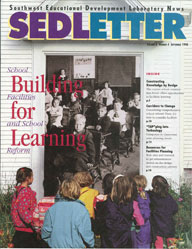Resources for Facilities Design and Planning
Web SitesCouncil of Educational Facilities Planners International This Web site contains CEFPI's Issuetrak series that may be printed or downloaded. Articles include "Gross Square Feet per Student," which is helpful in estimating square footage and offers hints for deciding the size of certain areas based on program characteristics. Also in the "Issuetrak" series are questions for facilities planners to ask before beginning the planning process, how to estimate costs for technology, and how to plan for a school's lighting requirements. The site also contains a search engine for abstracts of CEFPI Journal articles and links to a directory of facility planning consultants | |
| School Planning & Management Magazine School Planning & Management Magazine publishes articles on school design, maintenance, and construction. The current issue is available on-line as well as the most recent Construction Report published by the magazine, which features construction statistics by region. This user-friendly site also has an archive indexed by subject and provides direct links to previously published articles. | |
| The National Clearinghouse for Educational Facilities http://www.ncef.org This Web site is arranged by topics including "Planning & Finance," "Facility Design," and "Operations and Maintenance." It includes a helpful "Frequently Asked Questions" section under each topic. There is a search engine so users can search the clearinghouse database by title or keywords. It also has on-line photographs of the "National Facility of the Month." | |
| Publications Department of Education Office of Civil Rights, ADA Compliance with the Americans with Disabilities Act: A Self-Evaluation Guide for Public Elementary and Secondary Schools This guide provides administrators with all of the information they need to know about ADA, including how to evaluate schools and plan for modifications in a straightforward manner. Each chapter discusses a separate topic related to ADA and contains self-evaluation material connected to the topic. The guide uses examples throughout to show how regulations would apply in specific instances. For example, in Chapter 2, the ADA definition of disability is discussed: "a physical or mental impairment that substantially limits one or more of the major life activities" of an individual. This is followed by several examples and discussions of situations where school administrators may need to decide whether an employee or student has a disability. ADA Compliance with the Americans with Disabilities Act: A Self-Evaluation Guide for Public Elementary and Secondary Schools is available from the Southwest Disability and Business Technical Assistance Center (SWDBTAC), 2323 South Shepherd Suite 1000, Houston, TX 77019; 800/949-4232, free of charge. | |
| United States General Accounting Office Report to Congressional Requestors, School Facilities: Profiles of School Condition by State This is the seventh and last report to Congress responding to its request for a comprehensive review of the condition of America's school facilities. The report is organized into profiles of the 50 states and the District of Columbia. The profiles outline state support for school facilities, including financial and technical assistance. They also contain state-specific results from the 1994 survey of school facilities, including the condition of school buildings, adequacy of environmental conditions, how facilities are meeting requirements of education reform and technology, funds necessary to bring schools into good condition, and the money needed to address federal mandates for providing access to the disabled and for reducing environmental hazards. Guides for understanding the data in the profiles are included in appendixes. Data for the profiles were compiled from two different studies. One was a 1994 survey of school conditions based on a national sample of 10,000 schools. The other was based on telephone interviews with state education agencies in 1995. This series of GAO reports on school facilities is available from the U.S. General Accounting Office, P.O. Box 6051, Gaithersburg, MD 20884-6015, 800/512-6000. The first copy is free; additional reports are $2 each. School Facilities: Condition of America's Schools; School Facilities: America's Schools Not Designed or Equipped for 21st Century; Technology: America's Schools Not Designed or Equipped for 21st Century; School Facilities: Accessibility for the Disabled Still an Issue; School Facilities: America's Schools Report Differing Conditions; School Facilities: Profiles of School Condition by State; | |
| National Education Knowledge Industry Association's (NEKIA), PROBE: Designing School Facilities for Learning Beginning with an historical overview of how the current interest in school facilities came about, this publication presents articles that delve into many areas of concern for school districts facing renovations to or new construction of school buildings. Learning and facilities experts gather for a roundtable discussion about what we know and what we still need to know to help communities manage facilities needs. Writer Anne C. Lewis examines how architects are translating the latest research on school reform and improvement into facilities that support reform goals. Julie Miller profiles innovative architect Stephen Bingler, who relies heavily on "community dialogue" in designing schools for the 21st century. Other articles examine options for funding school construction; the role that color, lighting, noise, and other elements play in student learning and achievement; and how other states are managing their facilities dilemmas. |
Next Article: Credits

